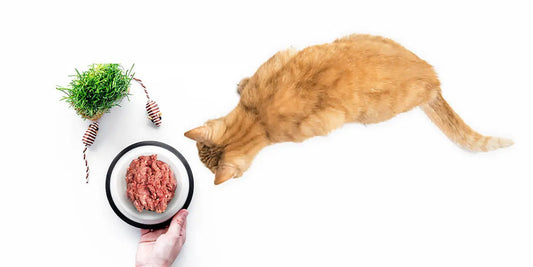
5 Common Reasons Your Dog Isn't Eating: Effective Solutions
“My dog won’t eat,” is a phrase no one wants to say at the vet or type into a search engine. But reduced appetite isn’t always a sign of a major health problem for your pup.
Any concerns about your pet’s health should be addressed with your vet right away. However, we first recommend researching some of the most common causes of appetite changes so that you can provide your vet with as much information as possible.
That’s the topic of this guide: We’re breaking down five reasons why your dog might be turning their nose up at their bowl to help you parse their palate and solve potential problems.
Overview of Canine Eating Behaviors
Just like a human picky eater, a cat or dog picky eater can cause frustration for their caretakers. However, picky eating can sometimes be a sign of problems beneath the surface—problems you may be able to help your vet identify.
The first step is to understand normal eating behaviors for dogs:
-
Dogs eat relative to portion size – Studies show that, as parent-provided portions increase, so does a dog’s food intake. In other words, dogs will typically eat more when they’re given more food—even if they don’t clean their plate at every meal.
-
Dogs understand routines – Dogs can become highly accustomed to routines, expressing a desire to eat at the same time each day.
-
Dogs have preferences – Dogs, like cats, may favor some foods over others—this might become apparent when you try to switch your dog to a new food.
Reason 1: Health Issues
With the above normal behaviors in mind, let’s explore some of the potential sources of abnormal eating behaviors in dogs—like underlying health issues. For example, dogs with gastrointestinal diseases or conditions may show signs of a reduced appetite.
If you suspect that your dog has an underlying health problem, observe factors related to other areas of their lifestyle and make note of any changes to:
-
Energy level or sociability
-
Water intake
-
Self-isolation habits
-
Sleep schedules
-
Anxiety level or overall disposition
-
Frequency or quality of bowel movements or urination
Even if you’re a pet health guru feeding your pup fresh dog food, minor illnesses or chronic conditions can still disrupt your pet’s appetite. If you suspect there might be more at play, take time to observe any other notable changes or symptoms and report these to your vet.
Reason 2: Dental Problems
If your dog is hesitant to crunch on their kibble, gnaw on their favorite bone, or take crispy freeze-dried liver treats during training, they might be facing dental problems.
Watch for signs of dental pain or symptoms, like:
-
Bad breath
-
Loose teeth
-
Gum bleeding or inflammation
-
Lesions inside dogs’ lips
If you see obvious signs of dental distress, make an appointment with your vet promptly. In the meantime, ask them for recommendations for keeping your dog fed and comfortable while you await an examination and dental care. Your vet may suggest soft foods, a liquid diet, or other alternatives to solid food.
Reason 3: Vaccinations or Medications
If your dog recently started a new medication or just received a routine vaccination at the vet, reduced appetite could be a side effect.
Today’s vets recommend core vaccines for:
-
Canine parvovirus (CPV)
-
Canine distemper virus (CDV)
-
Canine adenovirus (CAV)
-
Rabies
-
Leptospirosis
They also strongly suggest using a heartworm preventative.
While these medications are highly recommended and safe, side effects are possible. If your dog’s changes in appetite coincide with a recent medical treatment, ask your vet about any secondary impacts on diet or behavior.
Reason 4: Environmental Changes
Dogs are highly sensitive to stimuli—especially if they haven’t been exposed to a specific situation before.
Your dog may eat less than usual if:
-
You recently moved them to a new home
-
You’re traveling to a new place with your dog
-
You’re hosting visitors in your home
-
They can hear fireworks, thunder, or other frightening stimuli
-
They’re sharing a space with another dog
For permanent environmental changes, you can help dogs transition by:
-
Increasing time spent outside
-
Practicing trained behaviors (and reinforcing with treats , such as duck neck dog treats)
-
Showing them affection
-
Keeping their favorite beds, blankets, toys, and treats available
If your dog only has to tolerate an environmental change temporarily, consider making their food more enticing by adding a dog treat or special topping (like venison dog treats or freeze-dried minnows) to their bowl. If their behavior persists when they return to their normal environment, consider talking to your vet. For tips on transitioning your dog’s diet, see our blog on transitioning your dog to a raw diet.
Reason 5: Behavioral and Psychological Factors
Sensitivity to environmental change is just one kind of behavior or psychological factor that could impact your dog’s appetite. You may also notice your dog eating less if:
-
They’re stressed
-
They’re adjusting to a new routine
-
You’ve recently adopted them
-
A new pet recently moved into the home
Many kinds of stimulus changes can impact your dog’s behavior and appetite. Talk to your vet about training and comfort techniques you can use to help your dog adapt and develop normal eating habits.
Browse Darwin’s Dog Food Collection
If your dog isn’t eating as much as usual, they may be facing additional challenges—coping with change, dealing with a health issue, or simply expressing distaste for their food.
As dogs age, their dietary needs evolve, making it crucial to know what to feed old dogs for optimal health. Providing high-quality, nutrient-rich meals can help support their aging bodies and keep them active. Proper senior dog care also includes regular vet visits, joint support, and monitoring their food intake to ensure they’re getting the nutrients they need.
If you’re looking to enhance your dog’s nutrition, provide the highest quality food, and cater to their ancestral needs, consider switching to raw dog food from Darwin’s Natural Pet Products. Our Natural Selections collection is made from free-range meats and organic vegetables—and, with our pet food delivery service, you can get complete nutrition delivered right to your door.
It all starts with a personalized subscription plan tailored to your dog’s unique needs. Get started now!
Sources:
- Physiology and Behavior. Portion Size and Meal Consumption in Domesticated Dogs: An Experimental Study. https://pmc.ncbi.nlm.nih.gov/articles/PMC6488012/
- UC Davis. Nutritional Management of Gastrointestinal Disease. https://healthtopics.vetmed.ucdavis.edu/health-topics/canine/nutritional-management-gastrointestinal-disease
- UC Davis. Dental Care. https://healthtopics.vetmed.ucdavis.edu/health-topics/canine/dental-care
- UC Davis. Vaccination Guidelines for Dogs and Cats. https://healthtopics.vetmed.ucdavis.edu/health-topics/feline/vaccination-guidelines-dogs-and-cats
- UC Davis. Fear in Dogs. https://healthtopics.vetmed.ucdavis.edu/health-topics/canine/your-dogs-fear


